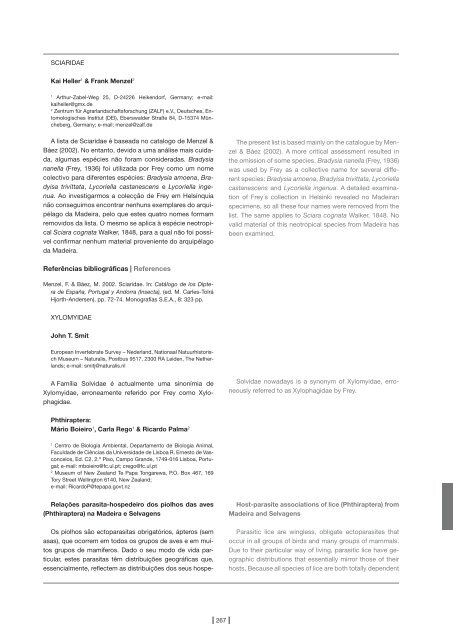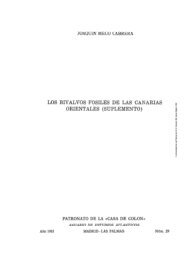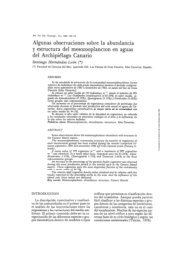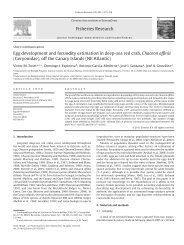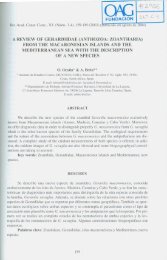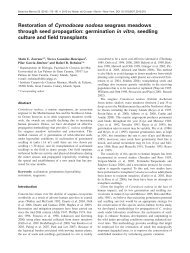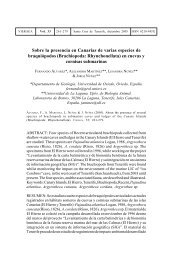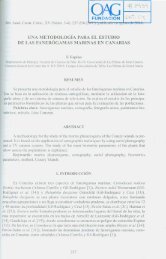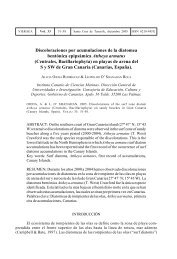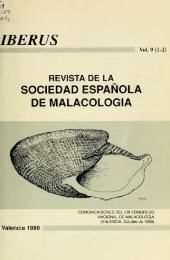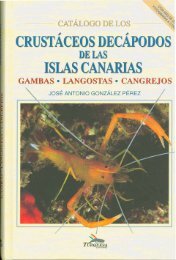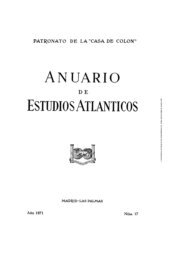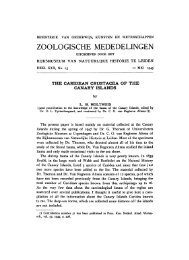of the madeira and selvagens archipelagos - redmic
of the madeira and selvagens archipelagos - redmic
of the madeira and selvagens archipelagos - redmic
Create successful ePaper yourself
Turn your PDF publications into a flip-book with our unique Google optimized e-Paper software.
SCIARIDAE<br />
Kai Heller 1 & Frank Menzel 2<br />
1 Arthur -Zabel -Weg 25, D -24226 Heikendorf, Germany; e -mail:<br />
kaiheller@gmx.de<br />
2 Zentrum für Agrarl<strong>and</strong>schaftsforschung (ZALF) e.V., Deutsches, Entomologisches<br />
Institut (DEI), Eberswalder Straße 84, D -15374 Müncheberg,<br />
Germany; e -mail: menzel@zalf.de<br />
A lista de Sciaridae é baseada no catalogo de Menzel &<br />
Báez (2002). No entanto, devido a uma análise mais cuidada,<br />
algumas espécies não foram consideradas. Bradysia<br />
nanella (Frey, 1936) foi utilizada por Frey como um nome<br />
colectivo para diferentes espécies: Bradysia amoena, Bradyisa<br />
trivittata, Lycoriella castanescens e Lycoriella ingenua.<br />
Ao investigarmos a colecção de Frey em Helsínquia<br />
não conseguimos encontrar nenhuns exemplares do arquipélago<br />
da Madeira, pelo que estes quatro nomes formam<br />
removidos da lista. O mesmo se aplica à espécie neotropical<br />
Sciara cognata Walker, 1848, para a qual não foi possível<br />
confirmar nenhum material proveniente do arquipélago<br />
da Madeira.<br />
Referências bibliográficas | References<br />
Menzel, F. & Báez, M. 2002. Sciaridae. In: Catálogo de los Diptera<br />
de España, Portugal y Andorra (Insecta), (ed. M. Carles -Tolrá<br />
Hjorth -Andersen), pp. 72 -74. Monografías S.E.A., 8: 323 pp.<br />
XYLOMYIDAE<br />
John T. Smit<br />
European Invertebrate Survey – Nederl<strong>and</strong>, Nationaal Natuurhistorisch<br />
Museum – Naturalis, Postbus 9517, 2300 RA Leiden, The Ne<strong>the</strong>rl<strong>and</strong>s;<br />
e -mail: smitj@naturalis.nl<br />
A Família Solvidae é actualmente uma sinonímia de<br />
Xylomyidae, erroneamente referido por Frey como Xylophagidae.<br />
Phthiraptera:<br />
Mário Boieiro 1 , Carla Rego 1 & Ricardo Palma 2<br />
1 Centro de Biologia Ambiental, Departamento de Biologia Animal,<br />
Faculdade de Ciências da Universidade de Lisboa R. Ernesto de Vasconcelos,<br />
Ed. C2, 2. º Piso, Campo Gr<strong>and</strong>e, 1749 -016 Lisboa, Portugal;<br />
e -mail: mboieiro@fc.ul.pt; crego@fc.ul.pt<br />
2 Museum <strong>of</strong> New Zeal<strong>and</strong> Te Papa Tongarewa, P.O. Box 467, 169<br />
Tory Street Wellington 6140, New Zeal<strong>and</strong>;<br />
e -mail: RicardoP@tepapa.govt.nz<br />
Relações parasita -hospedeiro dos piolhos das aves<br />
(Phthiraptera) na Madeira e Selvagens<br />
Os piolhos são ectoparasitas obrigatórios, ápteros (sem<br />
asas), que ocorrem em todos os grupos de aves e em muitos<br />
grupos de mamíferos. Dado o seu modo de vida particular,<br />
estes parasitas têm distribuições geográficas que,<br />
essencialmente, reflectem as distribuições dos seus hospe-<br />
267<br />
The present list is based mainly on <strong>the</strong> catalogue by Menzel<br />
& Báez (2002). A more critical assessment resulted in<br />
<strong>the</strong> omission <strong>of</strong> some species. Bradysia nanella (Frey, 1936)<br />
was used by Frey as a collective name for several different<br />
species: Bradysia amoena, Bradyisa trivittata, Lycoriella<br />
castanescens <strong>and</strong> Lycoriella ingenua. A detailed examination<br />
<strong>of</strong> Frey´s collection in Helsinki revealed no Madeiran<br />
specimens, so all <strong>the</strong>se four names were removed from <strong>the</strong><br />
list. The same applies to Sciara cognata Walker, 1848. No<br />
valid material <strong>of</strong> this neotropical species from Madeira has<br />
been examined.<br />
Solvidae nowadays is a synonym <strong>of</strong> Xylomyidae, erroneously<br />
referred to as Xylophagidae by Frey.<br />
Host -parasite associations <strong>of</strong> lice (Phthiraptera) from<br />
Madeira <strong>and</strong> Selvagens<br />
Parasitic lice are wingless, obligate ectoparasites that<br />
occur in all groups <strong>of</strong> birds <strong>and</strong> many groups <strong>of</strong> mammals.<br />
Due to <strong>the</strong>ir particular way <strong>of</strong> living, parasitic lice have geographic<br />
distributions that essentially mirror those <strong>of</strong> <strong>the</strong>ir<br />
hosts. Because all species <strong>of</strong> lice are both totally dependent


